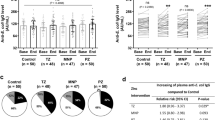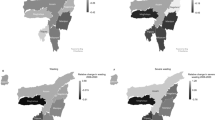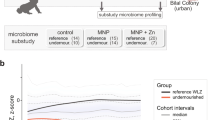Abstract
Background/Objective:
The efficacy of zinc combined with vitamin A or multiple micronutrients in preventing diarrhoea is unclear in African countries with high prevalence of human immunodeficiency virus (HIV)-exposed children. Potential modifying factors, such as stunting, need to be addressed. The objective of this study was to determine whether adding zinc or zinc plus multiple micronutrients to vitamin A reduces diarrhoea incidence, and whether this differs between the strata of stunted or HIV-infected children.
Methods:
We analyzed data from a randomized, controlled, double-blinded trial (ClinicalTrials.gov NCT00156832) of prophylactic micronutrient supplementation to children aged 6–24 months. Three cohorts of children: 32 HIV-infected children, 154 HIV-uninfected children born to HIV-infected mothers and 187 uninfected children born to HIV-uninfected mothers, received vitamin A, vitamin A plus zinc or multiple micronutrients, which included vitamin A and zinc. The main outcome was incidence of diarrhoea. Poisson regression was used in intent-to-treat analyses. Stratified analyses followed testing for statistical interaction between intervention and stunting.
Results:
We observed no significant differences in overall diarrhoea incidence among treatment arms. Stunting modified this effect with stunted HIV-uninfected children having significantly lower diarrhoea incidence when supplemented with zinc or multiple micronutrients compared with vitamin A alone (2.04 and 2.23 vs 3.92 episodes/year, respectively, P=0.024). No meaningful subgroup analyses could be done in the cohort of HIV-infected children.
Conclusions:
Compared with vitamin A alone, supplementation with zinc and with zinc and multiple micronutrients, reduced diarrhoea morbidity in stunted rural South African children. Efficacy of zinc supplementation in HIV-infected children needs confirmation in studies that represent the spectrum of disease severity and age groups.
This is a preview of subscription content, access via your institution
Access options
Subscribe to this journal
Receive 12 print issues and online access
$259.00 per year
only $21.58 per issue
Buy this article
- Purchase on Springer Link
- Instant access to full article PDF
Prices may be subject to local taxes which are calculated during checkout

Similar content being viewed by others
References
Baqui AH, Zaman K, Persson LA, El Arifeen S, Yunus M, Begum N et al. (2003). Simultaneous weekly supplementation of iron and zinc is associated with lower morbidity due to diarrhea and acute lower respiratory infection in Bangladeshi infants. J Nutr 133, 4150–4157.
Bess Jr JW, Powell PJ, Issaq HJ, Schumack LJ, Grimes MK, Henderson LE et al. (1992). Tightly bound zinc in human immunodeficiency virus type 1, human T-cell leukemia virus type I, and other retroviruses. J Virol 66, 840–847.
Bhutta ZA, Bird SM, Black RE, Brown KH, Gardner JM, Hidayat A et al. (2000). Therapeutic effects of oral zinc in acute and persistent diarrhea in children in developing countries: pooled analysis of randomized controlled trials. Am J Clin Nutr 72, 1516–1522.
Bobat R, Coovadia H, Stephen C, Naidoo KL, McKerrow N, Black RE et al. (2005). Safety and efficacy of zinc supplementation for children with HIV-1 infection in South Africa: a randomised double-blind placebo-controlled trial. Lancet 366, 1862–1867.
Brown KH, Rivera JA, Bhutta Z, Gibson RS, King JC, Lonnerdal B et al. (2004). International Zinc Nutrition Consultative Group (IZiNCG) technical document #1. Assessment of the risk of zinc deficiency in populations and options for its control. Food Nutr Bull 25 (Suppl 2), S99–S203.
Dijkhuizen MA, Wieringa FT, West CE, Muherdiyantiningsih, Muhilal (2001). Concurrent micronutrient deficiencies in lactating mothers and their infants in Indonesia. Am J Clin Nutr 73, 786–791.
Fawzi WW, Mbise R, Spiegelman D, Fataki M, Hertzmark E, Ndossi G (2000). Vitamin A supplements and diarrheal and respiratory tract infections among children in Dar es Salaam, Tanzania. J Pediatr 137, 660–667.
Garrib A, Jaffar S, Knight S, Bradshaw D, Bennish ML (2006). Rates and causes of child mortality in an area of high HIV prevalence in rural South Africa. Trop Med Int Health 11, 1841–1848.
Gupta DN, Mondal SK, Ghosh S, Rajendran K, Sur D, Manna B (2003). Impact of zinc supplementation on diarrhoeal morbidity in rural children of West Bengal, India. Acta Paediatr 92, 531–536.
Hamill PV, Drizd TA, Johnson CL, Reed RB, Roche AF, Moore WM (1979). Physical growth: National Center for Health Statistics percentiles. Am J Clin Nutr 32, 607–629.
Hoffman DJ, Lee SK (2005). The prevalence of wasting, but not stunting, has improved in the Democratic People's Republic of Korea. J Nutr 135, 452–456.
Labadarios D, Steyn NP, Maunder E, MacIntryre U, Gericke G, Swart R et al. (2005). The National Food Consumption Survey (NFCS): South Africa, 1999. Public Health Nutr 8, 533–543.
Long KZ, Rosado JL, Montoya Y, de Lourdes Solano M, Hertzmark E, DuPont HL et al. (2007). Effect of vitamin A and zinc supplementation on gastrointestinal parasitic infections among Mexican children. Pediatrics 120, e846–e855.
Long KZ, Santos JI, Rosado JL, Lopez-Saucedo C, Thompson-Bonilla R, Abonce M et al. (2006). Impact of vitamin A on selected gastrointestinal pathogen infections and associated diarrheal episodes among children in Mexico City, Mexico. J Infect Dis 194, 1217–1225.
Luabeya KK, Mpontshane N, Mackay M, Ward H, Elson I, Chhagan M et al. (2007). Zinc or multiple micronutrient supplementation to reduce diarrhea and respiratory disease in South African children: a randomized controlled trial. PLoS ONE 2, e541.
Nchito M, Friis H, Michaelsen KF, Mubila L, Olsen A (2006). Iron supplementation increases small intestine permeability in primary school children in Lusaka, Zambia. Trans R Soc Trop Med Hyg 100, 791–794.
Osendarp SJ, Santosham M, Black RE, Wahed MA, van Raaij JM, Fuchs GJ (2002). Effect of zinc supplementation between 1 and 6 mo of life on growth and morbidity of Bangladeshi infants in urban slums. Am J Clin Nutr 76, 1401–1408.
Papathakis PC, Rollins NC, Chantry CJ, Bennish ML, Brown KH (2007). Micronutrient status during lactation in HIV-infected and HIV-uninfected South African women during the first 6 mo after delivery. Am J Clin Nutr 85, 182–192.
Penny ME, Marin RM, Duran A, Peerson JM, Lanata CF, Lonnerdal B et al. (2004). Randomized controlled trial of the effect of daily supplementation with zinc or multiple micronutrients on the morbidity, growth, and micronutrient status of young Peruvian children. Am J Clin Nutr 79, 457–465.
Rahman MM, Vermund SH, Wahed MA, Fuchs GJ, Baqui AH, Alvarez JO (2001). Simultaneous zinc and vitamin A supplementation in Bangladeshi children: randomised double blind controlled trial. BMJ 323, 314–318.
Sazawal S, Black RE, Bhan MK, Jalla S, Sinha A, Bhandari N (1997). Efficacy of zinc supplementation in reducing the incidence and prevalence of acute diarrhea—a community-based, double-blind, controlled trial. Am J Clin Nutr 66, 413–418.
Sempertegui F, Estrella B, Camaniero V, Betancourt V, Izurieta R, Ortiz W et al. (1999). The beneficial effects of weekly low-dose vitamin A supplementation on acute lower respiratory infections and diarrhea in Ecuadorian children. Pediatrics 104, e1.
Smuts CM, Dhansay MA, Faber M, van Stuijvenberg ME, Swanevelder S, Gross R et al. (2005a). Efficacy of multiple micronutrient supplementation for improving anemia, micronutrient status, and growth in South African infants. J Nutr 135, 653S–659S.
Smuts CM, Lombard CJ, Benade AJ, Dhansay MA, Berger J, Hop le T et al. (2005b). Efficacy of a foodlet-based multiple micronutrient supplement for preventing growth faltering, anemia, and micronutrient deficiency of infants: the four country IRIS trial pooled data analysis. J Nutr 135, 631S–638S.
Umeta M, West CE, Haidar J, Deurenberg P, Hautvast JG (2000). Zinc supplementation and stunted infants in Ethiopia: a randomised controlled trial. Lancet 355, 2021–2026.
Untoro J, Karyadi E, Wibowo L, Erhardt MW, Gross R (2005). Multiple micronutrient supplements improve micronutrient status and anemia but not growth and morbidity of Indonesian infants: a randomized, double-blind, placebo-controlled trial. J Nutr 135, 639S–645S.
Van den Broeck J, Mackay M, Mpontshane N, Kany Kany Luabeya A, Chhagan M, Bennish ML (2007). Maintaining data integrity in a rural clinical trial. Clin Trials 4, 572–582.
WHO (2005a). Technical updates of the guidelines on Integrated Management of Childhood Illness (IMCI): evidence and recommendations for further adaptations. World Health Organization: Geneva.
WHO (2005b). World Health Organization global database on child growth and nutrition. http://www.who.int/nutgrowthdb/database/en/.
WHO (2007). The World Health Organization child growth standards. www.who.int/childgrowth/en/.
Acknowledgements
We thank Professors Jeffrey K Griffiths and Parke E Wilde for their critical review. We also thank the study participants and staff who carried out the study.
This study was supported by grants from the United States National Institute of Health (1 UO1 AI45508-01, 1 K24 AI/HDO1671-01, D43TW05572-01 to Dr Bennish) and the Wellcome Trust (Wellcome Grants 62925 to Dr Bennish and 063009 to Dr Van den Broeck), NICHD/FIC International Maternal and Child Health Training Grant D43-TW001277-11 and International Nutrition Foundation Fellowship support to Dr Chhagan.
Author information
Authors and Affiliations
Corresponding author
Additional information
Contributors: MK Chhagan planned and completed the current analysis and prepared the manuscript draft. ML Bennish was principal investigator for the study and responsible for study design. J Van den Broeck and KA Luabeya served as Project Directors. N Mpontshane supervised the fieldwork. The manuscript was critically reviewed and approved by all of the authors.
Conflict of Interest
KA Luabeya, N Mpontshane, J Van den Broeck and M L Bennish all received salary and travel support form the National Institutes of Health.
Rights and permissions
About this article
Cite this article
Chhagan, M., Van den Broeck, J., Luabeya, KK. et al. Effect of micronutrient supplementation on diarrhoeal disease among stunted children in rural South Africa. Eur J Clin Nutr 63, 850–857 (2009). https://doi.org/10.1038/ejcn.2008.78
Received:
Revised:
Accepted:
Published:
Issue Date:
DOI: https://doi.org/10.1038/ejcn.2008.78
Keywords
This article is cited by
-
Evaluating the cost-effectiveness of preventive zinc supplementation
BMC Public Health (2014)
-
Zinc supplementation in children and adolescents with acute leukemia
European Journal of Clinical Nutrition (2013)



